Onam 2023: The Most Celebrated Festival of Malayalees
Onam is a 10-day harvest festival celebrated in the Indian state of Kerala. It is one of the most important festival in Kerala and is considered to be the state’s own version of the Indian New Year. Onam is a time for family and friends to come together and enjoy a variety of cultural events, including boat races, snake boat races, and traditional dances.
Onam 2023 will be celebrated from August 17 to September 28. The main day of Onam is on August 28. On this day, people wear new clothes, visit temples, and feast on a traditional meal called Onam Sadhya. Onam Sadhya is a traditional vegetarian meal that consists of over 20 different dishes.

Onam History
The Onam festival is said to commemorate the homecoming of the legendary King Mahabali. Mahabali was a kind and just ruler who was loved by his people. However, he was also very powerful and this made the gods jealous. The gods decided to send Vishnu, one of the Hindu trinity, to defeat Mahabali. Vishnu took on the form of a dwarf named Vamana and challenged Mahabali to give him as much land as he could cover in three steps. Mahabali agreed and Vamana grew to enormous size, covering the earth and the heavens in his first two steps. With his third step, Vamana pushed Mahabali into the underworld. However, Mahabali was allowed to return to earth once a year to visit his people during Onam.The Onam festival is celebrated to commemorate the homecoming of the legendary King Mahabali. Mahabali was a benevolent and just ruler who was adored by his subjects. However, he was also very powerful, which made the gods envious. The gods decided to send Vishnu, one of the Hindu trinity, to defeat Mahabali. Vishnu took on the form of a dwarf named Vamana and challenged Mahabali to give him as much land as he could cover in three steps. Mahabali agreed, and Vamana grew to enormous size, covering the earth and the heavens in his first two steps. With his third step, Vamana pushed Mahabali into the underworld. However, Mahabali was allowed to return to earth once a year to visit his people during Onam.
Onam Maveli
The legend of King Mahabali, often referred to as Maveli, is at the heart of the Onam festival celebrated in Kerala, India. Maveli’s story is one of generosity, humility, and the spirit of unity, which continues to be cherished and commemorated by Keralites during the grand festivities of Onam.
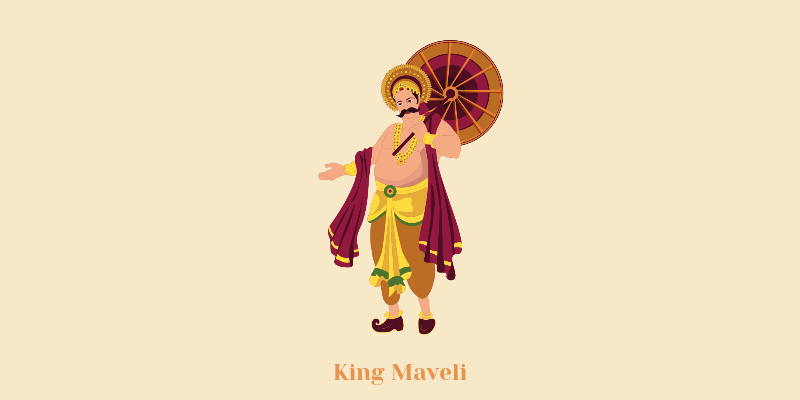
The Mythical King Mahabali
Mahabali, also known as Bali Chakravarthy, was a legendary king who ruled over the land of Kerala. His reign was characterized by justice, prosperity, and the well-being of his subjects. He was not only a powerful ruler but also known for his humility and compassion.
Vamana Avatar and the Asura King
According to Hindu mythology, Mahabali was a devotee of Lord Vishnu. However, his success and benevolence raised concerns among the gods, who feared his growing power. To curb his influence, Lord Vishnu took the form of Vamana, a dwarf Brahmin, and approached Mahabali for alms.
The Three Requests
Vamana, in his disguised form, asked Mahabali for three paces of land. The generous king agreed without hesitation, underestimating the true identity of the Brahmin. Vamana then grew to immense proportions and covered the entire universe in just three steps.
Maveli’s Benevolence Rewarded
Impressed by Mahabali’s humility and devotion, Lord Vishnu granted him a boon. Maveli, who had lost his kingdom, requested the boon that he could visit his subjects once a year. This annual visit by Maveli during Onam became a symbol of his continued care for his people.
Onam Celebrations
The festival of Onam is celebrated to welcome King Mahabali’s spirit during his annual visit. Keralites believe that during this time, their land becomes prosperous, and they indulge in festivities to honor the king’s memory. Homes are adorned with flower decorations, or Pookalams, and grand feasts, known as Onam Sadhya, are prepared.
Unity and Equality
The story of Mahabali transcends religious boundaries and emphasizes the values of humility, generosity, and unity. The tale symbolizes the triumph of good over evil and the importance of treating all individuals with respect and kindness.
Maveli’s Message
The legacy of Maveli continues to inspire Keralites to be kind-hearted, inclusive, and compassionate. Onam is not just a religious festival; it’s a cultural celebration that brings people together, fostering a sense of belonging and harmony.
Onam Pookalam
Onam, the vibrant and traditional festival of Kerala, is not only about sumptuous feasting but also about decking up homes with intricate flower designs. These floral arrangements, known as “Pookalam,” hold a special place in Onam celebrations, adding a burst of color and beauty to the festivities.
A Pookalam is a colorful flower arrangement that is made during Onam. It is made by placing flowers in a circular pattern on the ground. The Pookalam is a symbol of welcome and hospitality. It is believed that the flowers in the Pookalam attract the gods and goddesses to earth.
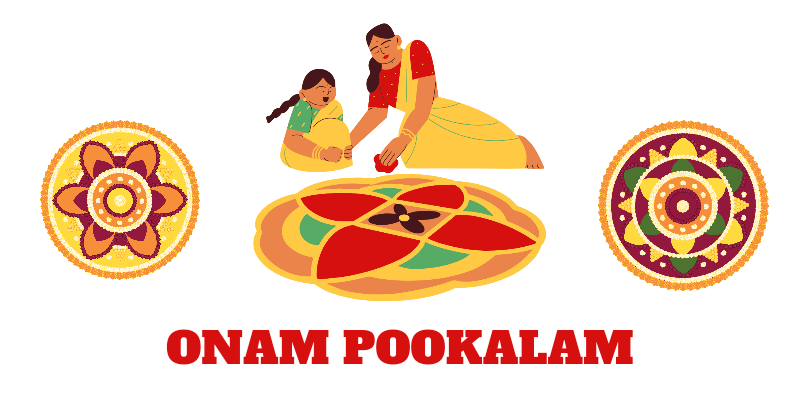
The Art of Pookalam
Pookalam, derived from the Malayalam words “poo” (flower) and “kalam” (art), is an art form that involves creating intricate and colorful flower designs on the ground. It’s a collective effort where families and communities come together to showcase their creativity and celebrate the spirit of Onam.
Traditional Flowers used in Onam Pookalam
A variety of flowers are used to create Pookalams, each contributing to the overall beauty and charm of the design. Some commonly used flowers include:
Thumba (Lucas Aspera): These tiny white flowers form the base of most Pookalams due to their size and availability.
Mukkutti (Little Tree Plant): These golden-yellow flowers are often used to add vibrancy to the design.
Chethi (Ixora): With its striking orange-red blooms, chethi flowers add a bold and captivating element.
Kakka Poovu (Raven’s Eye): These small, dark maroon flowers provide a contrast and depth to the design.
Chemparathi (Hibiscus): The bright red hibiscus flowers are used to add a splash of color to the Pookalam.
Thechipoovu (Aster): With its delicate white and purple petals, thechipoovu contributes a touch of elegance.
Creation of Onam Pookalam
Creating a Pookalam is a meticulous process that involves a keen eye for design and a steady hand. Here’s a general process of making a Pookalam:
Selecting the Area: A clean and open space is chosen as the canvas for the Pookalam.
Creating the Base: Thumba flowers are used to create a circular base, which serves as the foundation for the design.
Layering and Patterns: Other flowers are carefully layered to create intricate patterns, often inspired by traditional geometric designs or elaborate themes.
Collaboration: Friends and family members join in, each contributing to different sections of the design.
Finishing Touches: The Pookalam is completed with the addition of leaves, petals, and sometimes even colorful powders.
Daily Additions: Over the ten days of Onam, the Pookalam is expanded upon, with new layers of flowers and designs added each day.
Symbolism and Spirit of Pookkalam
Pookalam is more than just a decorative art form; it embodies the essence of unity, creativity, and cultural pride. The collective effort involved in creating these designs represents the spirit of togetherness that Onam celebrates. Each intricate petal and carefully chosen flower reflects the reverence Keralites have for nature and their deep-rooted connection with their traditions.
Onam Sadhya (Onam Special Food)
Onam Sadhya is a grand feast that holds a significant place in the hearts of the people of Kerala, India. This traditional vegetarian feast is prepared with meticulous care and presented with utmost devotion during the auspicious occasion of Onam. With a rich history and cultural significance, Onam Sadhya brings together flavors, colors, and traditions that reflect the essence of Kerala’s heritage.
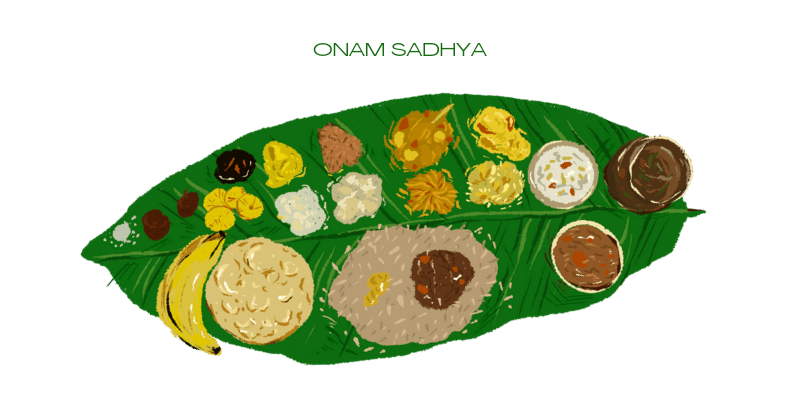
Onam Sadhya Preparation and Presentation
The preparation of Onam Sadhya is a labor of love that requires careful planning and coordination. The feast is typically served on a banana leaf and consists of an array of dishes, each with its own unique flavors and textures. The elaborate meal is served in a specific order, with rice being the centerpiece.
Key Dishes of Onam Sadhya
Rice: The meal starts with a portion of rice, usually served on the center of the leaf.
Parippu (Lentil Curry): A flavorful lentil curry made with mashed lentils, ghee, and a blend of spices.
Sambar: A tangy and spicy vegetable stew with a base of lentils and tamarind.
Rasam: A peppery, tamarind-based soup that cleanses the palate and aids digestion.
Avial: A medley of mixed vegetables cooked in a coconut and yogurt gravy.
Thorran: A dry vegetable dish, often made with beans, carrots, or cabbage, and coconut.
Olan: A mild curry made from ash gourd and black-eyed peas cooked in coconut milk.
Pachadi: A sweet and sour side dish made with yogurt, coconut, and vegetables or fruits.
Kootu Curry: A flavorful mix of vegetables and lentils, cooked with aromatic spices.
Erissery: A dish made with pumpkin or yam cooked in a spiced coconut gravy.
Kalan: A tangy curry made with yogurt and raw bananas, seasoned with spices.
Pulissery: Another yogurt-based curry, often prepared with ripe mangoes or vegetables.
Injipuli: A sweet and tangy ginger tamarind chutney that adds a burst of flavor.
Pappadam: Crispy lentil wafers that provide a crunchy texture to the meal.
Parippu Pradhaman: A creamy dessert made from lentils, jaggery, coconut milk, and spices.
Cultural Importance of Onam Sadhya
Onam Sadhya not only pleases the taste buds but also represents the unity and diversity of Kerala. It brings families, friends, and communities together to celebrate their cultural roots. The meticulous preparation of each dish, the arrangement on the banana leaf, and the act of sharing the meal promote a sense of togetherness and harmony.
Onam Traditional Dress
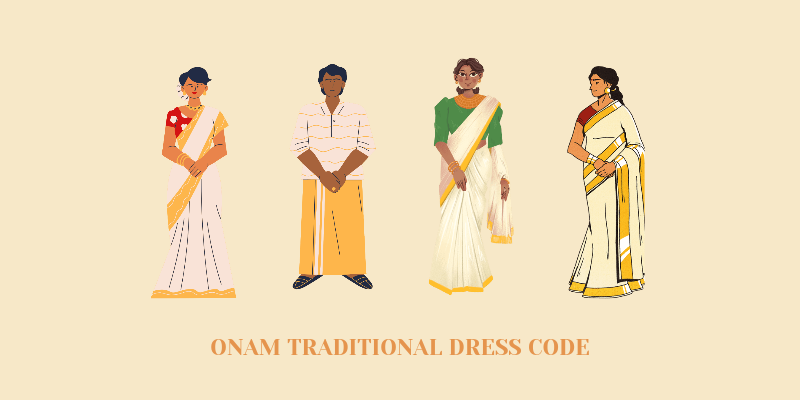
Women’s Onam Traditional Dress
The traditional dress worn by women during Onam is called the “Kerala Sari” or “Kasavu Sari.” It is a graceful and elegant ensemble that embodies the essence of Kerala’s culture. The Kerala Sari is typically off-white or cream in color with a golden border, known as the “Kasavu.”
Components of the Kerala Sari
Mundu: The lower garment, a plain white piece of cloth, is draped around the waist and worn like a skirt.
Kavani: This is a jacket-like garment that is worn over the upper body. It is usually short-sleeved and falls just below the waist.
Blouse: A short-sleeved blouse is worn underneath the Kavani, and its color often complements the golden border of the sari.
Onam Adornments and Accessories
Women often pair the Kerala Sari with traditional jewelry, which includes gold necklaces, earrings, bangles, and a decorative hairpiece known as “Mullapoo.” The jewelry adds a touch of elegance to the ensemble, enhancing the overall look.
Men’s Onam Traditional Dress
Men’s traditional attire for Onam includes the “Mundu” or “Dhoti” paired with a “Kurta.” The Mundu is a piece of cloth that is wrapped around the waist and legs, while the Kurta is a long shirt worn on the upper body. The Mundu is usually white or off-white, while the Kurta may be in a coordinating color.
Onam Accessories for Men
Men may also adorn themselves with traditional jewelry such as gold chains, bracelets, and rings. In addition, they often wear a “Mundu Neriyathu,” a cloth draped over the shoulder, which adds a touch of formality to the attire.
Children’s Onam Attire
Children also participate in the Onam celebrations by wearing miniature versions of the traditional dress. Young girls wear mini Kerala Saris, and boys don small Mundus paired with shirts or Kurtas.
The traditional dress worn during Onam is more than just clothing; it’s a reflection of Kerala’s rich cultural legacy and the people’s deep connection with their roots. As Keralites come together to celebrate Onam, the vibrant colors and graceful attire serve as a visual representation of the unity, tradition, and beauty that define this remarkable festival.
Onam Songs
Onam, the vibrant festival of Kerala, is not only marked by grand feasts and flower decorations but also by the melodious strains of Onam songs. These songs, known as “Onapattukal,” play a significant role in adding rhythm, joy, and a sense of cultural bonding to the festive celebrations.
Traditional Onam Songs
Onapattukal are traditional folk songs that are sung during the Onam festivities. These songs are known for their catchy tunes, lively beats, and meaningful lyrics that celebrate the spirit of Onam and the themes of unity, prosperity, and joy.
Themes of Onapattukal
King Mahabali’s Arrival: Many Onam songs narrate the story of King Mahabali’s annual visit during Onam and the anticipation of his arrival. These songs evoke a sense of nostalgia and reverence for the legendary king.
Pookalam and Nature: Onapattukal often describe the beauty of Pookalams (floral arrangements) and the vibrant colors of Onam. They celebrate the harmony between nature and the festivities.
Unity and Togetherness: Several songs emphasize the importance of unity, family, and community during Onam. They highlight the spirit of togetherness and the joy of celebrating with loved ones.
Harvest and Prosperity: Onam is also a harvest festival, and some songs celebrate the abundance of nature’s bounty and the prosperity it brings to the land.
Folk and Contemporary Blend
While traditional Onapattukal continue to be cherished, modern interpretations and adaptations of these songs have also gained popularity. Contemporary musicians infuse modern beats and arrangements into these songs, making them more appealing to younger generations while retaining the essence of the festival.
Famous Onam Songs:
“Thiruvona Kaineettam” – This iconic song welcomes King Mahabali and expresses the joy of receiving his blessings.
“Poovili Poovili Ponnonamaayi” – A popular song that captures the essence of Onam with its lively melody and descriptive lyrics.
“Onam Vannallo Oonjalittallo” – This song paints a picture of Onam celebrations, describing the festive mood and activities.
Community Singing and Performances
Onapattukal are often sung collectively during various Onam events, including cultural programs, competitions, and processions. Communities come together to sing and dance to these songs, fostering a strong sense of cultural identity and unity.
With the advent of digital platforms and social media, Onam songs have found a new avenue for reaching a wider audience. Music videos and online performances have given Onapattukal a global platform, allowing people from different parts of the world to enjoy and participate in the festivities.
Traditional Onam Games
Onam games are a reflection of the joyful and inclusive nature of the festival. They range from outdoor sports to indoor activities, appealing to people of all ages and backgrounds. These games are not just a form of entertainment but also a way to bond with family and friends.
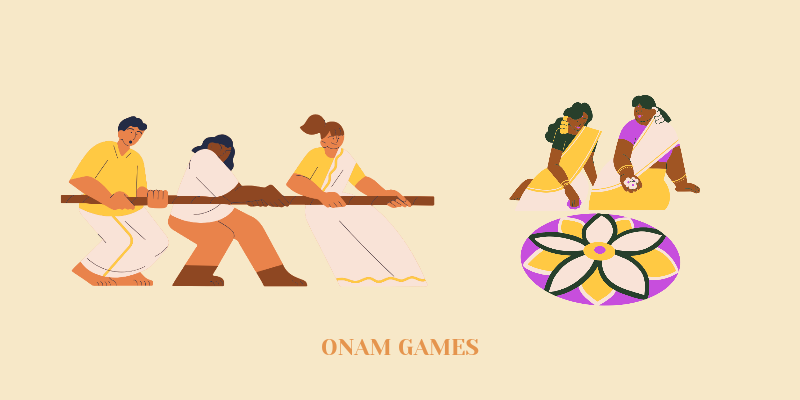
Snake Boat Races (Vallam Kali)
One of the most iconic Onam games is the thrilling Snake Boat Race. Large traditional boats, known as “Vallams,” are beautifully decorated and rowed by teams of skilled oarsmen. The races take place on rivers and water bodies, showcasing the strength and coordination of the participants.
Tug of War (Kuzhimuttu)
Tug of War is a team-based game that requires strategy, strength, and teamwork. Two teams compete by pulling opposite ends of a rope, and the team that successfully pulls the opposing team over a designated line wins.
Pulikkali (Tiger Dance)
Pulikkali is a colorful and lively folk art performance where participants paint themselves as tigers and dance to energetic beats. The vibrant spectacle is a visual treat that attracts both participants and spectators.
Uriyadi (Pot Breaking)
Uriyadi is a traditional sport where a clay pot filled with goodies is suspended high above the ground. Participants, often blindfolded, take turns trying to break the pot using a stick, while others cheer and guide them.
Talappanthukali (Ball Game)
Talappanthukali is a traditional ball game that resembles modern cricket. It involves two teams, and the objective is to hit a ball with a bat and score runs. The game is a blend of fun, physical activity, and friendly competition.
Athappookkalam (Floral Carpet)
While not a game in the traditional sense, creating intricate floral designs, or Pookalams, can be seen as a creative and artistic activity during Onam. Communities come together to create elaborate designs using colorful flower petals.
Modern Adaptations
While traditional Onam games continue to be cherished, modern variations of these games have emerged, adding a contemporary touch to the celebrations. Cultural programs, sports events, and competitions are organized in various communities to celebrate the festival.
Whether you’re hosting a grand feast or creating a festive atmosphere at home, here are some creative Onam decoration ideas to infuse your surroundings with the spirit of the festival.
Onam Decoration Ideas
1. Pookalam (Floral Arrangements)
Pookalam is an integral part of Onam celebrations. Create intricate and colorful flower designs on the ground to welcome King Mahabali. Use a variety of flowers to add vibrancy and depth to the arrangement. Encourage family members and friends to join in, making it a collaborative and joyous activity.
2. Floral Torans and Hangings
Adorn doorways and entrances with colorful floral torans (garlands) or hanging flower strings. You can also use banana leaves and flowers to create decorative hangings that instantly set a festive tone.
3. Colorful Rangoli Designs
Incorporate traditional Rangoli designs using colored powders, rice flour, or flower petals. These intricate patterns add a touch of artistry to your doorstep and complement the overall festive ambiance.
4. Creative Lanterns and Diyas
Illuminate your home with decorative lanterns and diyas (oil lamps). Choose lanterns in vibrant colors or create your own using colored paper. Place diyas around the house to create a warm and inviting glow.
5. Floral Centerpieces
Enhance your dining table with beautiful floral centerpieces. Arrange fresh flowers in decorative vases or floating arrangements. Choose flowers that represent the colors of Onam, such as yellow, orange, and white.
6. Banana Leaf Decor
Embrace the traditional aspect of Onam by incorporating banana leaves into your decorations. Use them as placemats, table runners, or even as wall hangings to infuse authenticity into your décor.
7. Handcrafted Crafts and Artwork
Encourage your family to create handmade crafts that reflect the spirit of Onam. Paint clay pots, make paper flower garlands, or design intricate paper crafts to adorn your living spaces.
8. Fabric Drapes and Curtains
Use vibrant fabrics with traditional patterns to drape over furniture or as curtains. These fabrics can instantly transform your space, adding a touch of festivity.
9. Onam-themed Wall Art
Print or create wall art that depicts Onam themes, such as King Mahabali, Pookalam designs, and traditional dancers. Hang these artworks to showcase your appreciation for the festival.
10. Community and Eco-friendly Decor
Consider involving your community in eco-friendly decoration initiatives. Use recycled materials and natural elements to create decorations that reflect sustainability and community spirit.
11. Hanging Ornaments and Garlands
Hang colorful ornaments, garlands, or ribbons from ceilings or doorways to create a festive and playful atmosphere. These elements can add movement and energy to your décor.
12. Onam-themed Table Settings
For your Onam Sadhya feast, set the table with traditional brass utensils, banana leaves, and neatly arranged plates. Incorporate small floral arrangements or decorative napkins to enhance the visual appeal.
Stay tuned to KERALA SCAPES for more interesting Kerala related articles!
